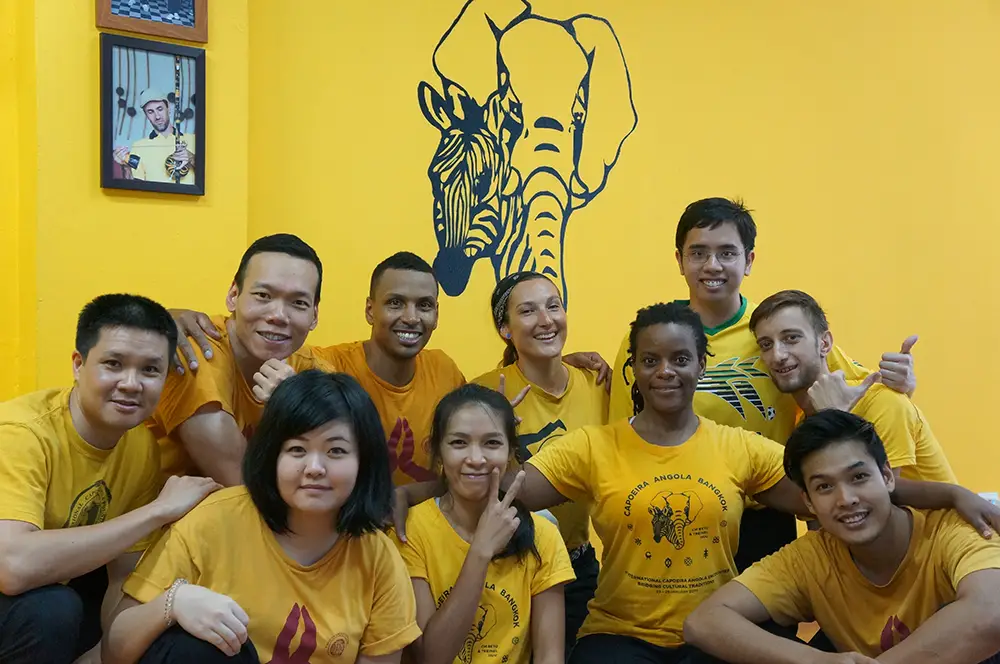The Rio 2016 Olympic Games which ended not too long ago brought a spontaneous worldwide interest in all things Brazilian, from travel, to politics, to traditional arts. The image of the iconic statue of Christ the Redeemer on top of Corcovado Mountain in Rio de Janeiro, the dire political crisis involving the Brazilian president, the Zika virus panic, and the various artistic representation of Brazilian culture have found their way all over the Internet.
Bangkok Brazil Fever
This spike in interest about Brazil will hopefully sustain itself so that the Brazilian people can reap the benefits of hosting such an expensive event. If you live in Bangkok, you can continue your fascination with the largest country on the American continents by participating in the activities organized by Capoeira Angola Bangkok.
What is Capoeira?
Capoeira is a martial art and ritual combat dance born from the influences brought by slaves from the African continent into Brazil. Between the 16th and 17th centuries, great numbers of slaves were brought by the Portuguese into Central and South America. With them came their African cultural heritage that mixed elements of dance, fight, ritual, and music into what today is known as Capoeira.
Capoeira’s three main styles are Angola, Regional and Contemporânea, with Capoeira Angola, the form you can experience in Bangkok, being the more traditional one. As the name suggests, its roots are from Angola, a southern African country which was almost depopulated during the slave trade.
Capoeira Angola Bangkok
Capoeira Angola Bangkok has been running as a non-profit organization since 2006 and operates under the leadership of Phu Huynh, a Capoeira practitioner from the United States. Although of Vietnamese origins, Phu Huynh has been studying, training and teaching capoeira since 2001 when he witnessed his first live Capoeira demonstration while living in Chicago. “It captivated me,” recalled Huynh.
As a martial artist, his primary references in Capoiera are Contramestre Beto de Freitas and Mestre Cobra Mansa, two highly respected Brazilian masters. Huynh has been in Thailand for the past ten years where he works as a researcher, but his passion for Capoeira has never foundered.
Speaking about the interest in Capoeira in Bangkok, Phu Huynh confessed that “it is somewhat limited, perhaps due to the foreignness and lack of familiarity to Capoeira.” We hope that this will change, as it seems that more and more people are looking into what Brazilian culture, arts and traditions are all about.
“Capoeira allows someone the rare opportunity to learn a new cultural art, while enriching their understanding of musical rhythms and improving their health and fitness,” explained Huynh. “It also is learned in an inherently social context, so students naturally develop new friendships and community through Capoeira.”
Capoeira is for everyone!
Although at first sight Capoeira might not be for someone who in not flexible and with a lean body, in fact, Capoeira is for everyone. “It is especially for those willing to learn and try something new and overcome their own physical and mental challenges,” confirmed Huynh.
A major misconception about Capoeira is that it is merely a sport that is practiced for fitness or a martial art used as an effective fighting technique. In fact, it is a rich cultural expression with a long history. “Learning the culture, music and history of the art is just as essential for understanding Capoeira as are the martial art applications.”
Of course, in Thailand, Capoeira is not nearly as popular as Muay Thai nor more popular than any other Asian martial art. But this is something to be expected as many find the musical, cultural and Portuguese language aspects of Capoeira particularly challenging.
Nevertheless, Capoeira Angola Bangkok is made up of a thriving group of people. “Our students are a mix of Thai nationals, expats, and international travelers visiting Bangkok for a short period. They come from very diverse backgrounds and professions but are connected by their passion to learn Capoeira.”
The organization also has a very strong kid’s programme which, according to their website is designed “to promote a sense of well-being in children by developing their sense of self-worth and self-esteem through social interaction and play rooted in respect for oneself and others.”
Where to practice Capoeira in Bangkok
The Capoeira classes take place on the 3rd floor of Silom Plaza on Silom Road in Bangkok. The nearest skytrain station is BTS Chong Nonsi on the Silom line (take exit 3). Practitioners must wear long pants, a comfortable shirt that can be tucked in (no tank tops) and flat shoes.
It costs 2,000 baht per month for unlimited training classes or 400 baht per session (200 baht for students, interns, volunteers). Classes are open to all adults and teenagers aged 15 or above and instruction is conducted in both Thai and English. There’s an outdoor class in a public park on the last Saturday of every month.
If you want to find out more about Capoeira Angola Bangkok, you can follow them on Facebook or call at 089 206 9495 (English or Thai).






Ref: The Never Lonely Planet, Salvador Bahia Brazil. (Martin R Oliver)
Capoeira originated in Brazil, Quote, Capoeira a martial art of self defense and mental balance created by African slaves hundreds of years ago, can be seen practiced by local kids in the squares and on the beach. Someone playing a traditional instrument called a Berimbau dictates the speed and movements performed. In the early days, slaves were punished by their owners if caught fighting, so the music was invented for a sort of cover up so the noise of the fight could not be heard. The art of Capoeira is uniquely identified with swaying, head butts, hand stands and swinging feet. It is very clever but in modern Capoeira no physical contact is made.
Yes, I now remember that you also wrote about capoeira in your first book!